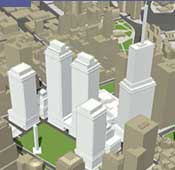|
In April 2002, the Lower Manhattan Development Corporation (LMDC) and the Port Authority put out a request for proposals for architectural firms to provide consulting services for the redevelopment of the World Trade Center site. The firms were required to submit their proposals by May 6 -- a turnaround of only a few weeks -- and 15 teams of architects responded. The LMDC and Port Authority announced at the end of May that they had selected the firm of Beyer Blinder Belle to design six overall "land-use options" or "concept plans" to determine how the streets, buildings, public spaces and transportation needs of Lower Manhattan could be arranged in the 16-acre block.
The selection of Beyer Blinder Belle, which was best known for its acclaimed restoration work on Grand Central Terminal and Ellis Island, received a mixed reaction. Herbert Muschamp, architecture critic for The New York Times, published a blistering article in which he criticized the narrow timeframe of the process and wrote, "The selection of the New York architecture firm Beyer Blinder Belle to design a master plan for Ground Zero and the financial district confirms once again that architecture will play no more than a marginal role in the redevelopment of Lower Manhattan." Steve Cuozzo responded a few days later in The New York Post, writing, "[W]hat the [architecture critics] really crave are the far-fetched fantasies that clog the pages of unreadable design magazines -- not precisely the thing for the Financial District, generator of $3 trillion in capital annually and one-fifth of the city's tax revenue."
Beyer Blinder Belle's six designs, which were collaborations with three other architecture firms, including Skidmore, Owings & Merrill and Peterson/Littenberg, both of whom would later participate in the next round of designs, were released on July 16 and were met with almost uniformly negative complaints that they were banal, unimaginative, too similar to each other, and too focused on the commercial requirements of rebuilding. Robert Campbell, architecture critic for The Boston Globe, called the plans "shake and bake urban design; you just shuffle the same ingredients around." Ada Louise Huxtable, writing in The Wall Street Journal described the plans as "six cookie-cutter losers. … Called Memorial This and That as a gesture to the universal desire for commemoration, they are dedicated to maximum return on the land, while obviously begging the future." Although the decision to restore some of the streets that were lost when the original World Trade Center was built was widely praised, two of the plans (Memorial Park and Memorial Promenade) did not leave the footprints of the twin towers open, upsetting many of the families of those who died on Sept. 11.
| 


|
|
Less than a week after the presentation of Beyer Blinder Belle's plans, a public meeting, called "Listening to the City" was held in the Jacob Javits Convention Center. An estimated 4,000 to 5,000 New Yorkers attended the meeting and expressed their displeasure with the plans. A month later, on Aug. 14, the LMDC announced that in addition to feedback from the Listening to the City and other public events, it had received more than 5,000 e-mail suggestions, and that it had decided to invite "the most innovative architects and planners around the world to participate in an LMDC design study regarding the future of the World Trade Center site and surrounding areas."
View a slideshow of the six Beyer Blinder Belle plans.
| |